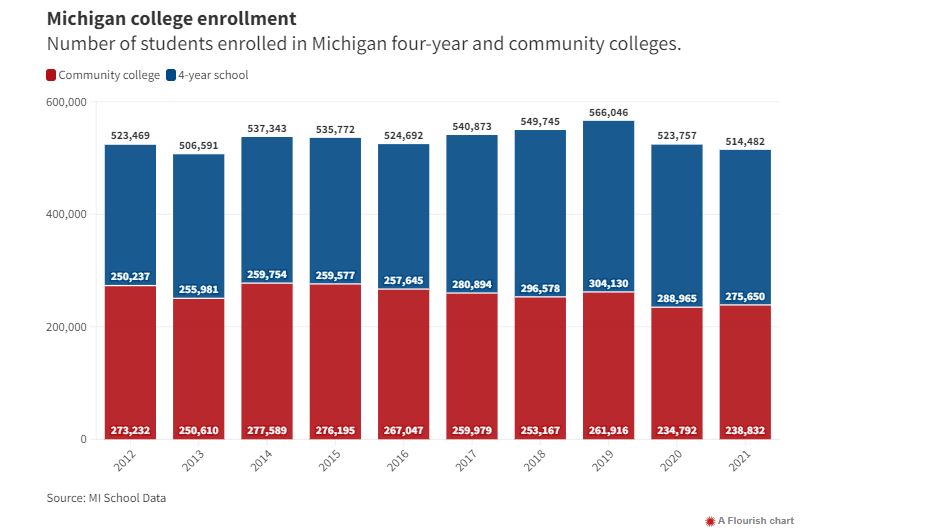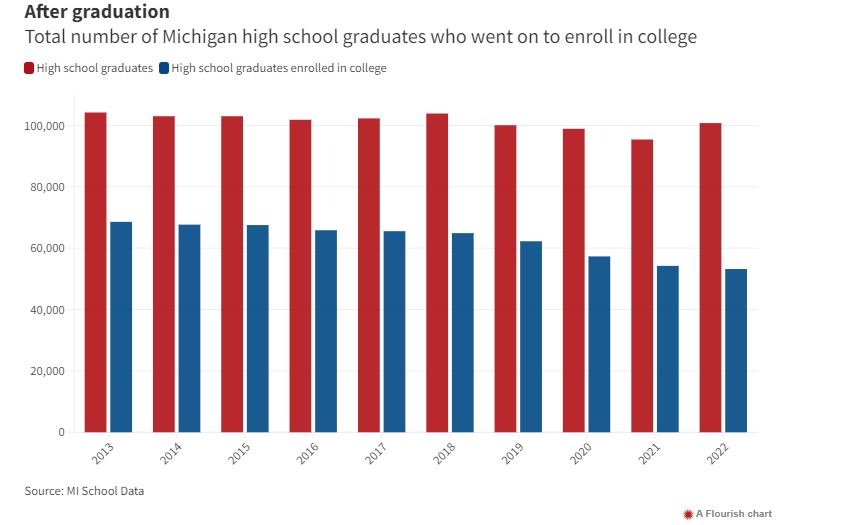Pandemic, Brain Drain Issues
Even before the pandemic, experts were anticipating a workforce crunch as baby boomers retired, and Michigan’s declining birth rate means there are fewer young adults to take their place. The Trump Administration’s more restrictive policies on immigration also curtailed an important labor source.
Those issues were all exacerbated by the pandemic. Retirements rose. Immigration became more problematic. Child care issues, health concerns and COVID-related burnout pushed some out of the job market. College enrollments dropped, even as the demand for skilled labor has increased.
Jeff Donofrio, CEO of Business Leaders for Michigan, said his organization surveys its members every quarter. In recent surveys, 70% to 80% say they’re having trouble with hiring.
“That talent availability and quality is something they’re concerned about,” he said. “It’s across the board. They need people with journeyman cards and apprenticeships. They need people with associate’s degrees, and there are a significant amount with jobs that require a bachelor’s degree or higher.”
To complicate matters, Michigan is experiencing a brain drain as well-educated adults leave the state, Donofrio said. “It’s about 8,000 a year, and where are they going? To places that are growing fast in the knowledge economy and where their skills are needed and where there’s a density of higher-paying jobs that require higher education.”
Corewell Health, formed after a merger of the Beaumont and Spectrum health systems, employs about 60,000 people. These days, about 10% of those jobs are vacant, about twice the typical vacancy rate, says Jan Harrington-Davis, Corewell’s senior vice president for talent attraction.
“Before the pandemic, we were in a position where people would just come to us when we had an open position,” Harrington-Davis said. “Post-COVID, we’ve had to invest in programs with colleges and universities, invest in marketing, things where you really have to set yourself apart to be chosen in the job market.”
It’s the same story for his and many other organizations, said Bob Nykamp, chief operating officer for Pine Rest Christian Mental Health Services, which is headquartered in metro Grand Rapids and employs about 2,000 people.
“I heard a speaker at the Economic Club of Grand Rapids cite statistics that in 2018, there were 10 applicants for every job,” Nykamp said. “Now there are 10 jobs for every applicant.”
Pipeline is Shrinking
Michigan’s workforce shortage cuts across almost all sectors and all levels of skilled and unskilled jobs. But growing the skilled workforce is especially critical as the state seeks to increase the number of high-wage jobs and to retain and attract employers who pay those wages.
Among the Michigan jobs most in demand right now, according to the state Department of Labor & Economic Opportunity: Nurses and nurse’s aides, automotive service technicians and mechanics, computer support specialists, heating and air conditioning technicians, machinists, medical assistants, respiratory therapists and welders. All require a post-secondary degree or training.
Yet almost half of Michigan’s workers lack a post-secondary credential such as a bachelor’s or associate degree or an industry-recognized certification.
In 2021, 50.5% of Michigan residents age 25 to 64 had a post-secondary credential and 33.5% had at least a bachelor’s degree. That’s below the national averages of 53.7% and 36.5% respectively. Indeed, Michigan ranks last among the Great Lakes states in working-age adults with a post-secondary credential, according to data collected by the Lumina Foundation.
Even more disturbing, the numbers in the state’s higher-education pipeline are shrinking.
Enrollment in Michigan’s 15 public universities dropped 14% between fall 2012 and 2022. The decline has been more precipitous in the state’s 28 community colleges, where collective enrollment is down 18% between fall 2017 and 2021.
One reason is demographic: Gen Z is smaller than preceding cohorts. But demographics aren’t the whole story. Only 53% of Michigan’s Class of 2022 enrolled in college in fall 2022, well below the national average of 62%.
Several factors are in force, including rising wages that entice young adults into the job market vs. enrolling in college.
“There are several things going on here,” Baruah said. “We live in a state that has had a long history of not necessarily valuing a college degree because of a very strong and lucrative manufacturing base. You couple that with this recent narrative that all college will do is get you in debt.”
While there are examples of college graduates with high debt and low-paying jobs, Baruah said, for the most part, it’s a false narrative that discourages many young adults from pursuing post-secondary education.
“So you have a pipeline that’s not filling up with people wanting to get an associate’s or four-year degree,” Baruah said. “And you’ve also got employers saying, ‘Hey, I need these people (with degrees) and if I can’t find them in Michigan, I’m going to have to go someplace else.”
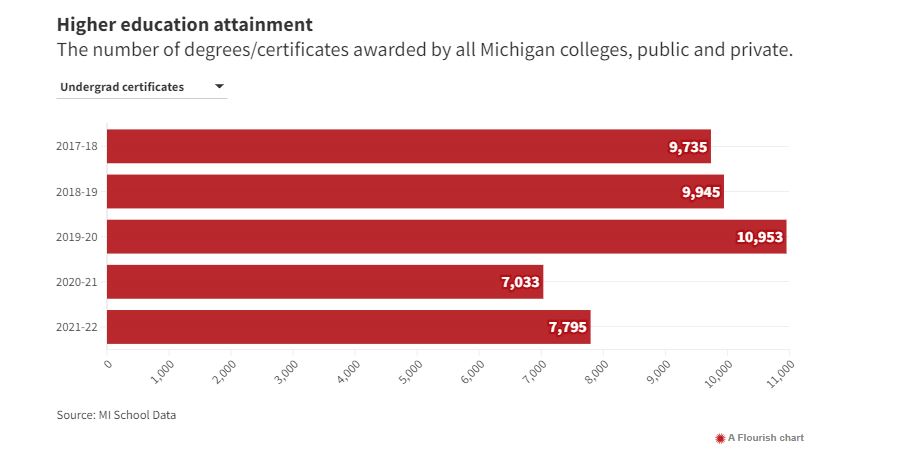
Value of Education
For all the recent focus on college debt, there’s considerable data showing higher education yields financial dividends for individuals.
“I like to share the statistic that after five years on the job, somebody with just a high school diploma earns an average of $20,000, while someone with a two-year community college degree is earning nearly $40,000 a year,” said Susan Corbin, director of the Michigan Department of Labor & Economic Opportunity.
Michigan’s median wage for a worker with a high school diploma or GED but no post-secondary credential was $32,639. That compares to $39,894 for someone with an associate degree; $59,740 for a bachelor’s, and $75,841 for those with a graduate degree, according to 2021 Census data.
A person with a high school diploma but no post-secondary credential is three times more likely to live in poverty and four times more likely to be unemployed, that Census data shows. That person is also more likely to drop out of the workforce entirely.
Post-secondary education doesn’t benefit only individuals and employers, experts say. It also helps create more stable families and communities. People with a college education are less likely to commit crimes, less likely to rely on social safety net programs, more likely to marry and stay married, and more likely to raise children in a two-parent household. College graduates tend to earn more money, so they pay more taxes.
It’s no coincidence that Michigan’s most affluent communities have large numbers of college graduates. Bloomfield Hills, Birmingham, Grosse Pointe Farms and East Grand Rapids are cities where more than 75% of adults have at least a bachelor’s degree and six-figure incomes are the norm.
There’s ample evidence of the value of higher education, says Russell Kavalhuna, president of Henry Ford College in Dearborn.
“Don’t take my word for it,” Kavalhuna said. “Go to the states that have a higher percentage of people with a post-secondary credential — and that includes things like a welding certificate or an associate’s degree. Those states have healthier citizens. They’re wealthier. They’re safer communities, and businesses look for those communities and invest significant capital resources there.”
While it’s clear that higher education is worth the time and money, many Michigan residents don’t understand that, Kavalhuna said.
“We’re not breaking through and explaining the basics,” he said. “If you have a bachelor’s degree vs. a high school diploma, you’re going to make twice as much money every year. That’s an average of $1.2 million more in lifetime earnings. So if you heard or suspect that college isn’t for you, let me disabuse you of that notion.”
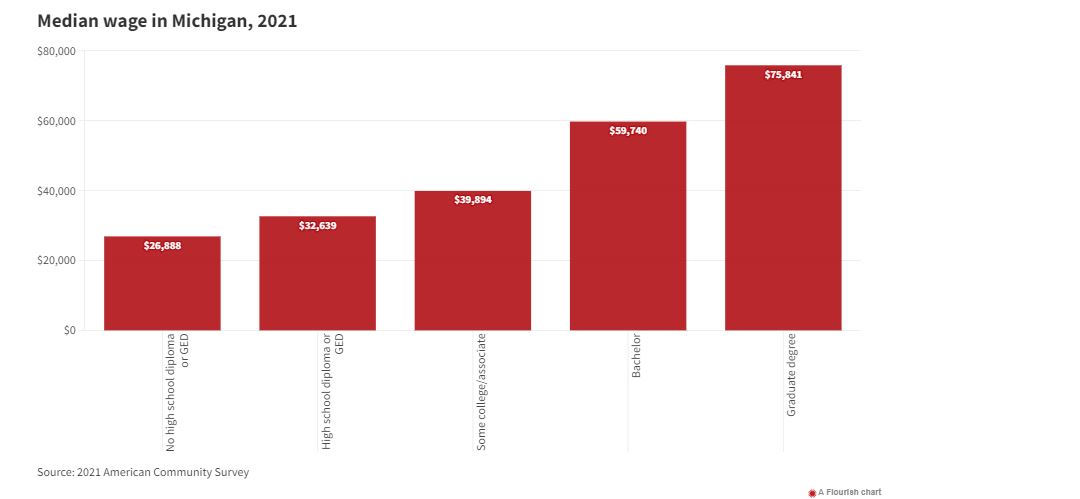
Giving a Push
The good news: There is bipartisan support in Lansing and among the state’s business community for the need to encourage more Michigan residents to obtain a post-secondary credential.
The Whitmer administration wants 60% of Michigan’s working-age residents to have a college degree or skill certificate by 2030. It’s currently 50.5%.
To that end, the state has created multiple new programs to subsidize the cost of post-secondary tuition and training. The Class of 2023 will be the first to benefit from the new Michigan Achievement Scholarship program, which gives $5,500 annual scholarships to in-state high school graduates who attend a Michigan public university and up to $2,750 for those enrolling at a community college.
There’s also Michigan Reconnect, a program started in 2021 that covers community college tuition or private vocational program fees for Michigan adults who lack a college degree. The eligibility age for that program was just lowered from age 25 to 21.
Between the two programs, most Michigan residents can now earn an associate degree without paying tuition.
Whitmer also just created the Michigan Department of Lifelong Education, Advancement and Potential, or MiLEAP, which will include oversight of preschools and higher education and be under direct control of the governor.
Michigan is unusual in that its Department of Education, which oversees K-12 education, is controlled by an elected board and not part of the governor’s administration. Moreover, Michigan’s 15 public universities are all independent entities with their own boards and, before MiLEAP, there was no state agency to oversee them.
More Coordination
The vision of MiLEAP is to create a more seamless pipeline between Michigan’s K-12 school system, its post-secondary institutions and the state’s employers.
It’s a worthy vision, many agree, but the to-do list is long: It includes improving K-12 outcomes. More coordination between K-12 schools and the state’s higher education system. More coordination between colleges on student transfers. More coordination between post-secondary programs and employers.
There also is a drive for employers to use “skills based” hiring for jobs that traditionally require a college degree but where one may not be necessary.
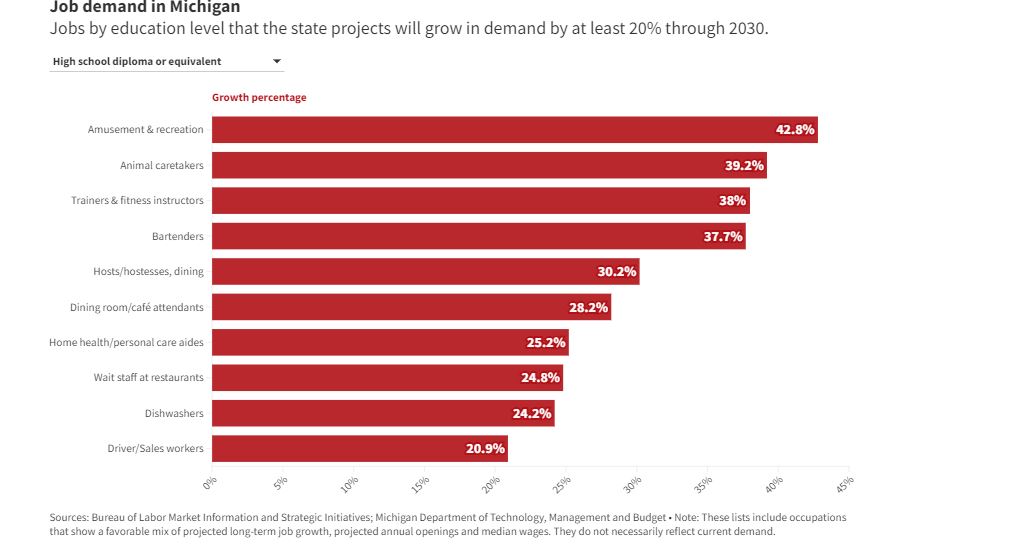
Another needed reform: Much more intensive efforts to reach out to the 49.5% of working-age Michigan adults who lack a post-secondary credential to help them upgrade their skills. That includes making sure they know about Michigan Reconnect and similar programs; helping them navigate the higher ed system, and providing wraparound services such as help with child care and transportation.
It’s important to address the fundamental barriers that keep people from obtaining a post-secondary credential, said Brad Hershbein, a senior economist at the Upjohn Institute for Employment Research.
“The problem is not tuition,” he said. “Tuition is relatively cheap.”
The real issues are “all of the hurdles of going to college – registering, figuring what what’s needed. Do I need to take this course? Is it going to count?” Hershbein said. “People need help with that. Investing in navigators and guidance and supports is really the biggest bang for the buck in getting people through.”
Aragones, the LCC student, agrees. When he decided to return to school, it was daunting just to figure out where to start, especially as a first-generation college student.
“You end up having to do a lot of research on your own,” he said. “I think that’s the biggest roadblock for a lot of people. It’s hard for people to hop on.”


